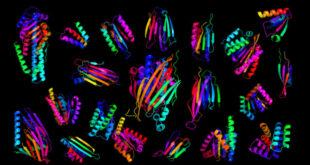Four commonly used artificial sweeteners – saccharine, sucralose, aspartame, and acesulfame potassium — can promote the horizontal transfer of antibiotic resistance genes, according to new research.
This digitally colorized, scanning electron microscopic (SEM) image, depicts a clump of yellow-colored, spheroid shaped, Staphylococcus aureus bacteria that were enmeshed in a blue-colored, filamentous extracellular matrix, which normally binds cells together within the body’s various tissue types Image credit: National Institute of Allergy and Infectious Diseases.
Artificial sweeteners, approved by the U.S. Food and Drug Administration (FDA), are widely being introduced as safe sugar substitutes in food and beverages as they provide a sweet taste but low calories or energy.
The consumption of artificial sweeteners has increased because of their potential to improve the health of individuals suffering from obesity, glucose intolerance, type II diabetes mellitus, and metabolic derangements.
The global consumption of these compounds is estimated to be approximately 117,000 metric tons annually.
After intake of food or beverages, artificial sweeteners can pass through the human digestive system without being metabolized and their concentration estimates can be as much as tens of mg/L in the human urine and even hundreds of mg/L in the human gastrointestinal tract.
With metabolically inert structures, these sweeteners can be directly excreted to the environment from the human body.
Currently, they are frequently detected in subsurface water, groundwater, and especially, wastewater treatment plants.
“We investigated if artificial sweeteners would encourage the transfer of antibiotic resistance genes between bacteria,” said senior author Dr. Jianhua Guo, a researcher in the Advanced Water Management Centre at the University of Queensland.
“Our previous studies have reported many common household items promote antibiotic resistance, so recently we started wondering if artificial sweeteners may also play a role.”
Dr. Guo and colleagues tested four commonly consumed artificial sweeteners: saccharine, sucralose, aspartame, and acesulfame potassium.
“Sweeteners significantly accelerated the exchange of bacteria through a process known as conjugation,” said first author Zhigang Yu, a Ph.D. student in the Advanced Water Management Centre at the University of Queensland.
“This process is regarded as the bacterial equivalent of sexual reproduction or mating and occurs when two bacteria come into direct contact.”
“The resistance genes are transferred from the donor to the recipient, and as a consequence, the recipient might become a multi-drug resistant strain of bacteria.”
“Given the high consumption of non-antibiotic pharmaceuticals, our findings highlight the potential risk associated with the presence of artificial sweeteners in our food and drinks.”
The results were published February 15, 2021 in The ISME Journal.
_____
Z. Yu et al. Nonnutritive sweeteners can promote the dissemination of antibiotic resistance through conjugative gene transfer. ISME J, published online January 21, 2021; doi: 10.1038/s41396-021-00909-x
 #Bizwhiznetwork.com Innovation ΛI |Technology News
#Bizwhiznetwork.com Innovation ΛI |Technology News




